How to Make Clip Art Change With the Path in Powerpoint
The best thing near PowerPoint is the animation. Edifice move into slideshows makes them come alive similar no static images could ever hope to exercise. Information technology's going to become even more than interesting when PowerPoint gets 3D capabilities with the Windows x Creators Update due in early on 2017.
In club to make things motion in PowerPoint, your objects demand a path (chosen a motion path) to travel from one location to another. Setting up the motion path used to be ho-hum, but at present it'south a simple, straightforward procedure.
i. Create an object
First, you must either create an object or insert 1 from the online clip fine art collection or your difficult drive.
1. Open PowerPoint, insert a new slide, and brand the background color dark bluish.
ii. Select a star from the drop list, then concord down the left mouse button and drag the cursor down and over to draw the star on your screen.
3. Click the object—the star—you want to animate.
four. From the Animations tab click Advanced Blithenesss > Add Animation.
v. Scroll down to the Motion Paths section, then choose a path from the presets, or select More Motion Paths from the list.
 JD Sartain
JD Sartain 6. When the Add Movement Path dialog opens, scroll through the dozens of options and choose i. Slide the Add Motion Path dialog to the right and scout the star move effectually the screen as you select and try out dissimilar Movement Paths.
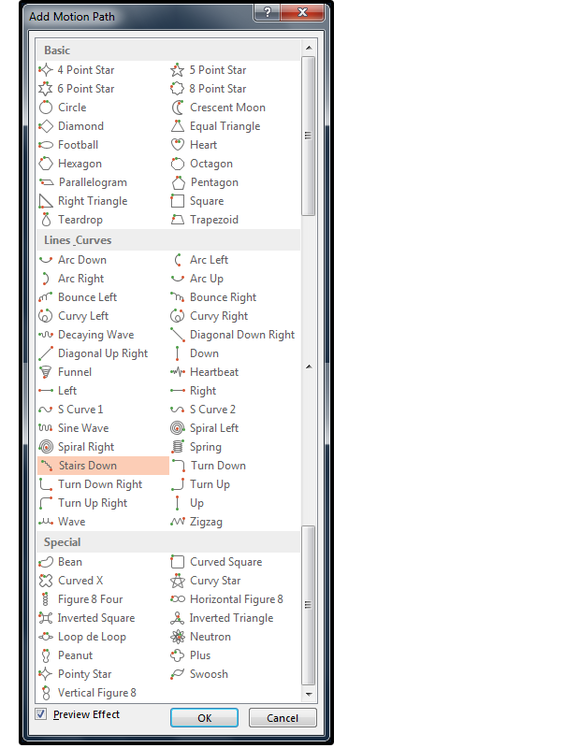 JD Sartain
JD Sartain 7. One time you choose a motion path, the path appears on the screen. If you want the path bigger, longer, smaller, or shorter, just grab the corner with the cerise arrow and drag the Motion Path in your chosen management.
8. Next, click Animation Pane (on the Ribbon menu), and it opens on the right side of your screen. Click the highlighted animation (5-Point Star 3) inside the console, then click the Play From button, which means play the animation from this point on.
9. Hover your cursor over the highlighted animation (5-Betoken Star three) inside the panel to run across the full description of this blitheness—in this example, "On Click, Stairs Down: 5-Point Star 3."
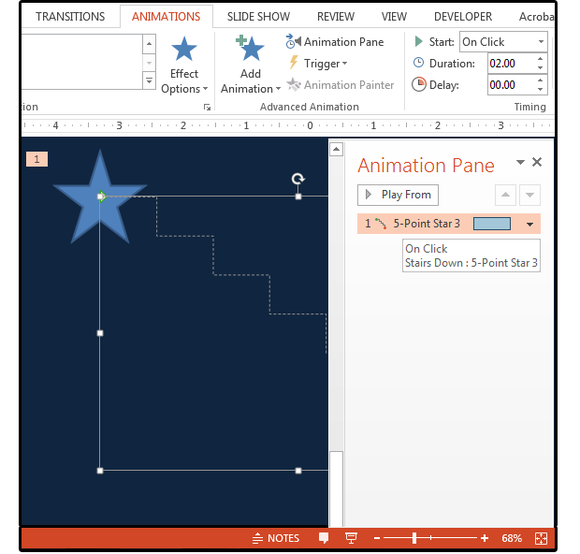 JD Sartain
JD Sartain 10. Subsequently the animation plays, click the down arrow to the right of the 5-Point Star 3 animation to come across the Timing and Furnishings Options submenu.
xi. The movement path submenu opens on the Timing tab. You lot have several timing options to define on this screen:
Start options include On Click, With Previous, or After Previous. This means you can fix the blitheness to begin on the click of the mouse, or with a previous animation that's already running, or subsequently a previously running animation.
Filibuster options are timed in seconds, which just means you can fix the animation on a fourth dimension filibuster clock for 10 number of seconds after the option you select above. For instance, if you lot choose Later Previous (equally the Commencement time for the blitheness), y'all could and so set a Delay time of 2 seconds. This is very of import if yous are trying to fourth dimension or match the audio to each slide.
Duration options are the fourth dimension, length, and speed of the animation (in seconds). These options are very useful if something in your animation has to match the audio. For example, I used this once in a slideshow when I had to fix the Duration/speed to Fast so the audio of the jingling bells would lucifer the movement of the jingling bells.
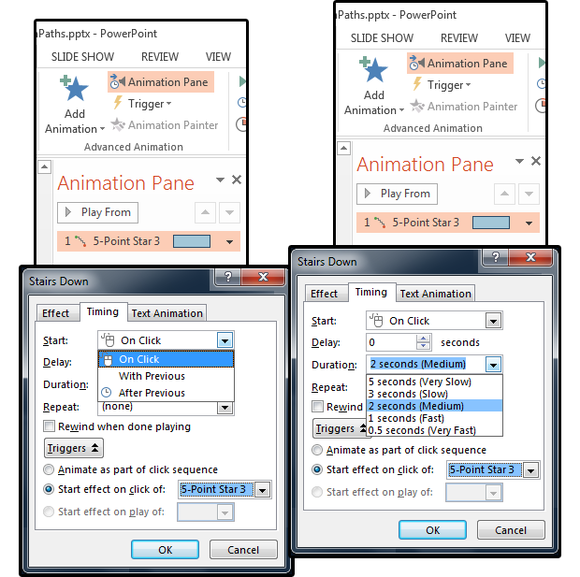 JD Sartain
JD Sartain Repeat is the number of times you desire the animation repeated in your slideshow. For example, in the original blitheness for the jingling bells, they merely moved back and forth two times. I needed them to keep moving/jingling until the end of the slide, or else the bells would be stationary while the audio was still jingling.
Rewind When Washed Playing is a checkbox. Select this if you desire the blitheness to return to the beginning later on information technology plays. This is also a useful tool if you want your animation to return to its original location later on it plays—for example, in case you demand the object returned to its original location for the next slide.
Triggers are options that allow you to cull which action will "trigger" or start the blitheness. Your choices are Animate as Part of a Sequence (the default), which starts the animation as part of the ongoing, active sequence; Showtime the Result On Click Of (the named animation), or Start Consequence on Play Of. In this example, it would exist started when something else is played, such as an audio or video file.
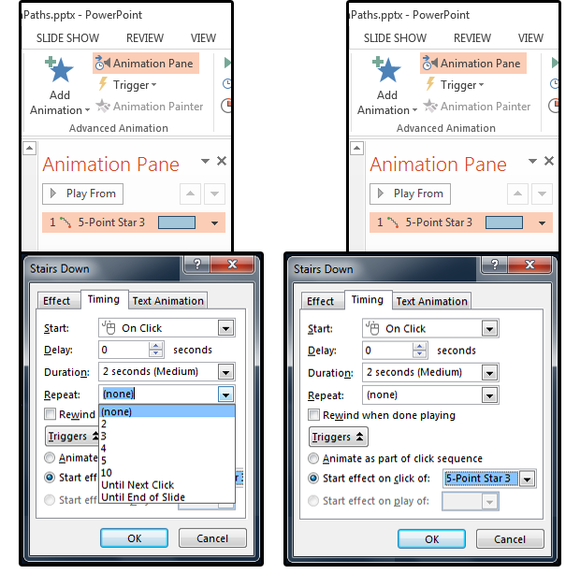 JD Sartain
JD Sartain 12. The next tab on the Motion Path (Stairs Down) submenu is Consequence. This submenu as well has several options that affect your animation:
Path Locked or Unlocked mean that if you click the object and move it, the animation path moves with the object (Unlocked) or remains at its current location (Locked).
Smooth Starting time/Shine End: You tin can have a full Shine Start or a total Smooth Stop, but not both. For case, if the slider on Smooth Start is pushed to the stop (5 seconds), the slider on Smooth Finish moves to 0 seconds. You lot can push them both halfway or one-third upwardly and two-thirds downwardly, only discover every bit y'all push one to the right, the other one adjusts to the left. What does this mean? Information technology means that the beginning (or the terminate) of the animation volition wearisome down and sort of slide into home plate in irksome motion. If both are set to 0, then animation will run evenly at the speed you selected in a higher place in the Duration option.
Bounce Terminate is a fun little feature that does simply that: The object bounces at the end of the blitheness. For example, imagine that you throw a ball across the room and when it hits the floor, information technology bounces until it stops.
Motorcar Contrary is a cracking feature. Y'all can ready the blitheness to get upwardly so back downwards the stairs, or within and then dorsum outside the door. Remember how this camera technique was used in the silent films? Aforementioned concept.
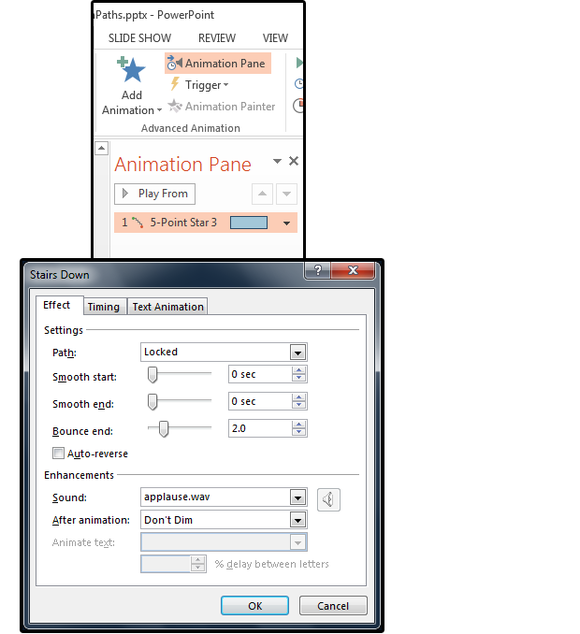 JD Sartain
JD Sartain You'll also come across options nether Enhancements:
Sound makes the slideshow. If you don't have a narrator, then sound furnishings or music are a must, or your audience will snooze. For Sound effects, click the down arrow beside the Sound field box, and and then choose a sound from the list. Only .wav files are accepted for sounds fastened to animations from this level.
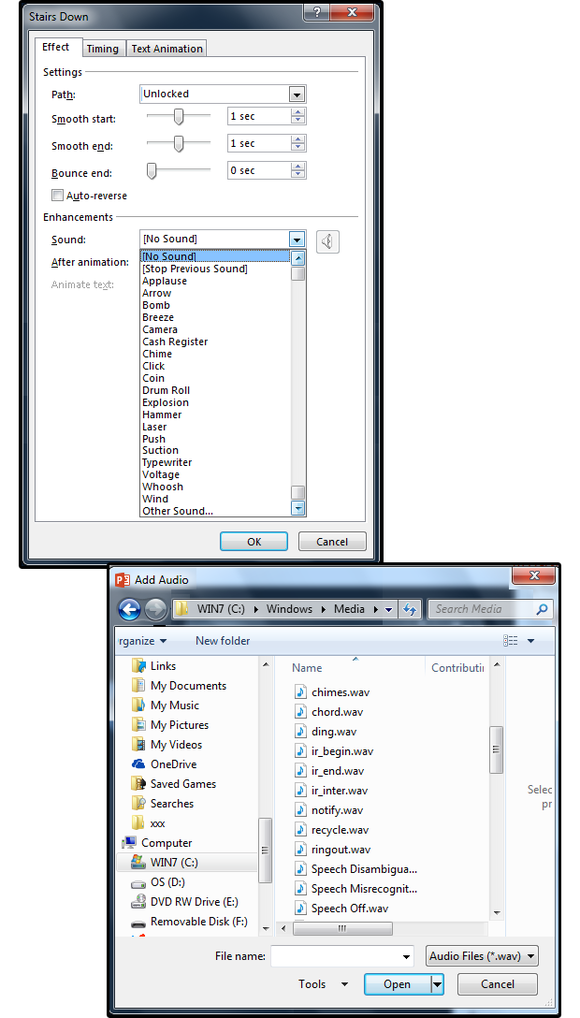 JD Sartain
JD Sartain NOTE: To insert a narrator's comments or music, from the Insert tab, click Audio, then cull Audio on My PC or Record Audio from the list. Navigate to your music or voice communication folder, select the appropriate file, and then click Insert.
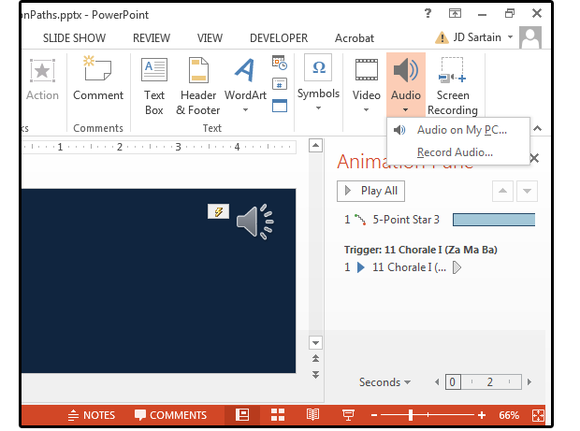 JD Sartain
JD Sartain .
After Animation is another cool feature that provides options including Colors (and More than Colors), Don't Dim, Hide After Animation, and Hibernate on Adjacent Mouse Click. If you choose a color, the object(s) in your animation volition modify to that color at the end. Don't Dim means don't fade it out into the background. Hide means hide the animation after information technology completes, or hide the animation when the user clicks the mouse.
Breathing Text is just bachelor if your animation includes characters, words, or sentences. Employ the options, when you desire the animation to affect 1 character or one word at a time. For case; say the animation is Pass up and you cull By Letter. The discussion Slap-up moves across the screen, and so down the screen, one letter at a fourth dimension. The adjacent field box is for the percentage of delay betwixt the messages, so the messages don't all move at the same time.
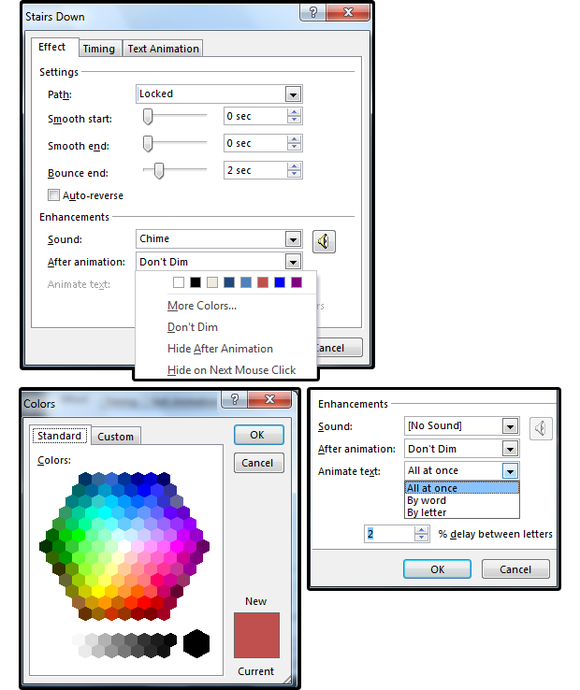 JD Sartain
JD Sartain The best style to larn how to create, manage, and manipulate animations and motion paths is to just open PowerPoint and play. Insert some basic shapes, add some fancy shape effects, and then add together some movement paths and see what happens. PowerPoint is non as powerful equally most animation-specific programs similar Flash, Maya, or Adobe Breathing, merely for beginners, it does the job.
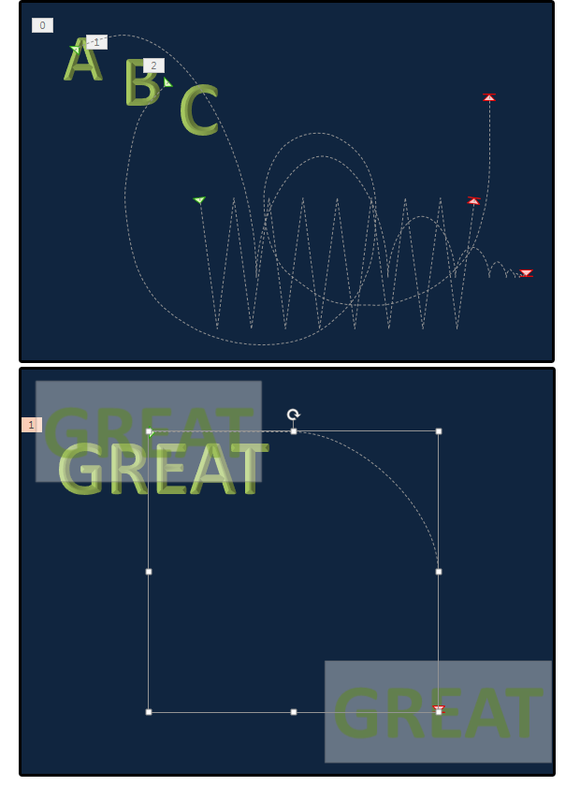 JD Sartain
JD Sartain richardsonvould1966.blogspot.com
Source: https://www.pcworld.com/article/415788/how-to-create-motion-paths-in-powerpoint.html
0 Response to "How to Make Clip Art Change With the Path in Powerpoint"
Post a Comment